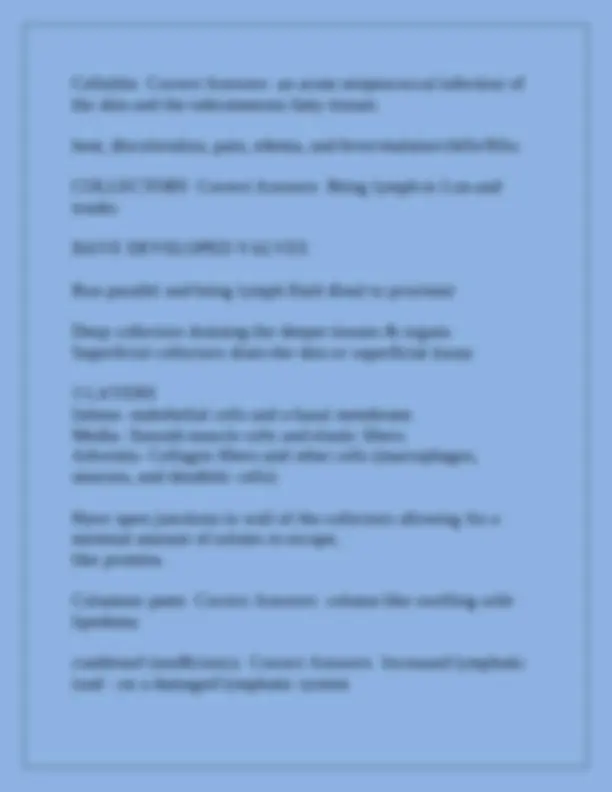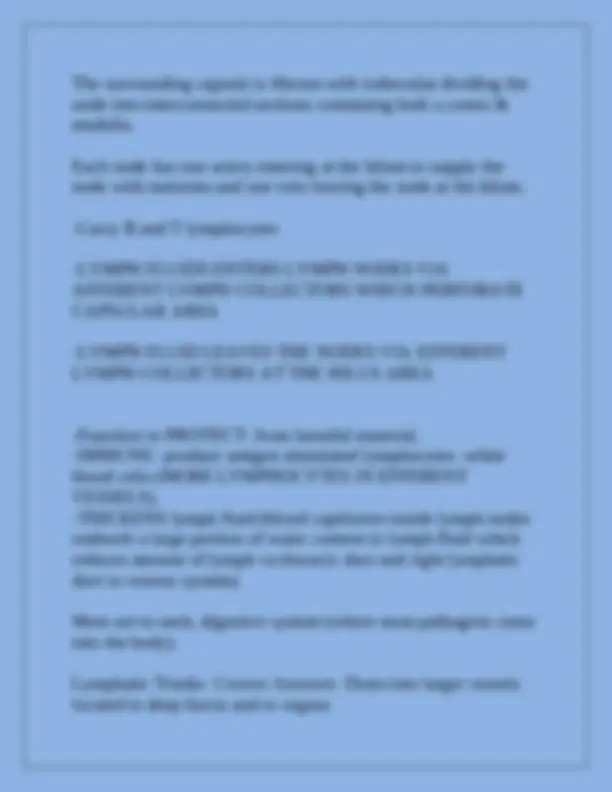














Study with the several resources on Docsity

Earn points by helping other students or get them with a premium plan


Prepare for your exams
Study with the several resources on Docsity

Earn points to download
Earn points by helping other students or get them with a premium plan
Community
Ask the community for help and clear up your study doubts
Discover the best universities in your country according to Docsity users
Free resources
Download our free guides on studying techniques, anxiety management strategies, and thesis advice from Docsity tutors
A comprehensive set of exam preparation questions and answers related to the lymphatic system. It covers various aspects of lymphatic anatomy, physiology, and pathology, including lymphatic drainage, lymphedema, and lymphatic disorders. Valuable for students studying anatomy, physiology, or related medical fields.
Typology: Exams
1 / 20

This page cannot be seen from the preview
Don't miss anything!













ABI Correct Answers assess for peripheral artery disease' .5-.8 reduced compression below .5 no compression 1.0-1.2-normal range above 1.2 abnormal vessel hardening from PVD can still use full compression but refer out Accessory drains Correct Answers Supraclavicular recieves lymph from occipital and internal jugular active hyperemia Correct Answers Anything that causes vasodilation Sphincter dilates to increase blood flow Increased volume=increased BCP=increased filtration=increased LL of H Healthy LS can compensate Activates safety factor I,e. massage, inflammation from infection, temp, sunbathing, exercise
Aplasia Correct Answers absence of vessels or nodes Arterial wounds Correct Answers toes, dorsum of foot, lateral malleolus, often full thickness. "punched out", pale, no granulation. decreased pulse, painful Dry/necrotic ABI test before compression Usually Small Deep with Cliff edge Axillary drains Correct Answers Subclavian trunk UE/mammary gland 75%/upper quadrants Bioimpedance Correct Answers electrical current must rely on population data Candida Albicans Correct Answers Oral Thrush Candida Vulvovaginitis Correct Answers vaginal inflammation, itchiness, and thick/white discharge.
Components of Lymphatic load Correct Answers Water, proteins, cells, long chain fatty acids Compression Level 1 Correct Answers 20-30mmhg lipedema mild lymphedema heaviness/fatigue in legs Compression Level 2 Correct Answers 30-40mmhg Moderate Lymphedema Venous stasis ulcers Compression Level 3 Correct Answers 40+ Severe Lymphedema Computerized Tomography (CT Correct Answers series of x- rays in cross- sectional images- more detailed than regular x-ray. can show difference b/w fatty tissue and lymph fluid accumulation with objective measurements Cryptococcosis Neoformans Correct Answers compromised immune systems.
Spread by pigeon droppings, unwashed raw fruit, or infected individuals. Presents as fluid filled bumps (papules), hardened patches (plaques), and ulcers Cutaneous candidiasis Correct Answers infection of skin and nails - especially in areas exposed to moisture, like between toes/fingers, genitals, axilla, & finger/toenails. Symptoms include red rash. Dermatophytes Correct Answers common label for40+fungal infections Dermis Correct Answers oBelow basal lamina oSpecialized connective tissue Superficial papillary layer » highly vascularized loose connective tissue » blood vessels » Initial lymphatics are at the border of this layer and the deep reticular layer. Distichiasis Correct Answers Praecox double row of eyelashes dilated collectors with valvular insufficiency Hereditary
Filariasis Correct Answers common roundworm: Wuchereria bancrofti. cause lymph vessels to dilate so valves become incompetent Worms "dance" around and this further damages the walls of the collectors Harem pants (pantaloons) Correct Answers like princess Jazmine pants in Aladin lipedema Hyperplasia Correct Answers Hyperplasia- ↑ size (diameter) = ↓ pumping (lymphangiectasis or megalymphtics) Hypoplasia Correct Answers most common- ↓ # or size of vessels (collectors) Hypoproteinemia Correct Answers Decrease in the amount of protein in blood= lower COPpl. Causes more water leaving the blood capillaries and accumulating in tissues Causes generalized edema (not lymphedema) Diet doesn't affect this If liver can't compensate-voids too many proteins
Inguinal drains Correct Answers pelvic lnn--> lumnbar lnn--> lumbar trunks--> cisterna chyli--> thoracic duct--> VA Initial Lymphatics AKA Correct Answers Lymph Plexus initial lymph collectors initial lymph vessels Initial Lymphatics Characterisitics Correct Answers LOCATED: Just under epitheal layer of epidermis and in the subendothelial lining of mucous membranes -LARGER THAN BCs -PICK UP LLs -Irregular lumen with a discontinuous basement membrane of a single layer of flat oak leaf in shape LECs integumentary system Epidermis Correct Answers Epidermis Multi-layer keratinized squamous epithelium oNo lymphatics oOn top of basal membrane Internal jugular drains Correct Answers jugular trunk recieves lymph fluid from submental, submandibular, parotid, posterior auricular jodhpurs (riding breeches) Correct Answers big hips and smaller calfs lipedema
The surrounding capsule is fibrous with trabeculae dividing the node into interconnected sections containing both a cortex & medulla. Each node has one artery entering at the hilum to supply the node with nutrients and one vein leaving the node at the hilum. -Carry B and T lymphocytes -LYMPH FLUIDS ENTERS LYMPH NODES VIA AFFERENT LYMPH COLLECTORS WHICH PERFORATE CAPSULAR AREA -LYMPH FLUID LEAVES THE NODES VIA EFFERENT LYMPH COLLECTORS AT THE HILUS AREA -Function to PROTECT- from harmful material, -IMMUNE- produce antigen stimulated lymphocytes -white blood cells (MORE LYMPHOCYTES IN EFFERENT VESSELS), -THICKENS lymph fluid (blood capillaries inside lymph nodes reabsorb a large portion of water content in lymph fluid which reduces amount of lymph va thoracic duct and right lymphatic duct in venous system). Most are in neck, digestive system (where most pathogens come into the body). Lymphatic Trunks Correct Answers Drain into larger vessels located in deep fascia and or organs
Has valves and structure like collectors but with thicker media layer 6 main ones- gastrointestinal, lumbar, parasternal, supraclavicular, subclavian, and jugular Main two-thoracic and right lymphatic duct Lymphedema Stage 0 AKA Correct Answers Subclinical or Latent Stage Lymphedema Stage 0 Characteristics Correct Answers -No swelling -Reduced TC and functional reserve -Normal tissue consistency but US can reveal changes -May have heaviness, achiness, warmth (Transient symptoms) -Education/prevention Lymphedema Stage 1 AKA Correct Answers Reversible Stage Lymphedema Stage 1 Characteristics Correct Answers -Pitting edema that goes down w/ elevation or treatment heavy, aching, fatigued -Puffy Goal-reduce edema
Hypoplasia Hereditary BLE below knees Milroy's disease Correct Answers -CONGENITAL lymphedema -swelling in one or both legs that begins at birth -Unable to form functional initial lymphatics -Usually female -Hereditary MLD direction Correct Answers Proximal to distal Direction is towards pertinent lymph node. Has a working and a resting phase. Noonan Syndrome Correct Answers Both sexes Non-Heriditary congenital or pre-cox wide-set eyes, small stature, webbed neck and a flat bridged nose. malformation of lymph vessels Parasternal drains Correct Answers Parasternal trunk drains 25% mammary gland Parotid drains Correct Answers internal jugular
tempoparietal of scalp/forehead/upper eyelid/lateral part of lower eyelid/anterior auricle Passive Hyperemia Correct Answers Increase in BCP caused by obstruction of venous return or deficiency of venous outflow Caused by Cardiac insufficiency Pregnancy Obesity CVI/DVT Sedentary lifestyle Flying on airplane Blood pools into capillaries=letting more blood into capillaries Activates safety factor Compression, elevation, muscle pump can help Perometer Correct Answers An infrared optoelectronic technology to detect & quantify limb volume & changes Volume is determined from the 3D silhouette cast of the limb; which is created when the limb is passed though a ray of optoelectronic sensors Podoconiosis Correct Answers Endemic non-filarial elephantiasis Geochemical
An increase in fluid in interstitium increases THP, slowing ultrafiltraion (BHP) and increasing uptake by lymphatics (LHP) Safety Factors (increase in lymphatic uptake) Correct Answers ACTIVE increase in lymphatic uptake will increase the lymphatic pumping- by stimulating lymphangion stretch → pumping Safety Factors (increase in protein) Correct Answers ACTIVE Increase in protein in the tissue will increase macrophage activity- phagocytosis Secondary Lymphedema Correct Answers caused by damage to lymphatic vessels that is most frequently due to cancer treatment, surgery, trauma, or burns Sporotrichosis Correct Answers skin infection via small openings in contact with soil or plant matter. small pink, red, or purple bump -will grow larger & may open up and is slow to heal. Stage 1 Lipedema Correct Answers Fat Swelling resolves with rest/elevation Stage 2 Lipedema Correct Answers Peau' d' orange Easy bruising Less resolution w/ rest and elevation
Stage 3 Lipedema Correct Answers Fibrosclerosis- hard connective tissue LARGE mass of skin Swelling doesn't recede Stage 4 Lipedema Correct Answers Fibrosclerosis/Elephantitis LARGER Masses of skin overhang LIPO-LYMPHEDEMA (becomes lymphedema at this stage) Stewart-Treves syndrome Correct Answers angiosarcoma in long standing chronic lymphedema which has often resulted from radical mastectomy Looks like a bruise; yet, not tender subcutaneous layer Correct Answers -Fat oConnective Tissue- collagen oLarger collectors oLarger vessels/nerves oTemp regulation and cushion. Submandibular drains Correct Answers internal jugular Lower eyelid/cheek/nose/upper&lower lip/lateral chin Submental Drains Correct Answers internal jugular Lower lip/chin/cheek Supraclavicular drains Correct Answers supraclavicular trunk
Causes are hot/humid weather, oily skin, hormones, & weakened immune system. tineacruris Correct Answers fungal infection of the groin; jock itch TURNER'S SYNDROME Correct Answers Non Hereditary congenital hypoplasia short, sterile, webbed neck 1 X chromosome FEMALE's ONLY can resolve Venous Doppler Correct Answers US to evaluate blood flow in arteries/veins. Can determine DVTs and/or venous involvement with lymphedema Venous Wounds Correct Answers Gaiter area or medial malleolus Shallow with diffuse edges
always has staining Exuding, granulating Usually Large